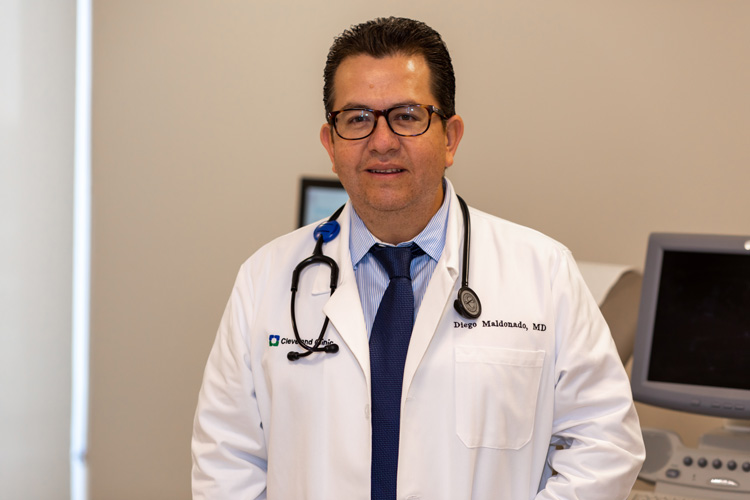
Veteran Cleveland Clinic Indian River Hospital pulmonary and critical care specialist Dr. Diego Maldonado clearly has a new spring in his step these days. If you ask him why he’ll likely say, “ELVR.”
ELVR stands for “endoscopic lung volume reduction,” a newly approved surgical procedure which, in Maldonado’s eyes, will be a game-changer for many people with advanced chronic obstructive pulmonary disease (COPD).
Johns Hopkins Medicine defines COPD as “a group of lung diseases that can interfere with normal breathing. According to the American Lung Association, more than 16 million Americans suffer from COPD. It is the third leading cause of death in the U.S.”
The two most common forms of COPD are chronic bronchitis and emphysema. As Maldonado starkly states, “emphysema means the destruction of the lung tissue.”
The National Heart, Lung and Blood Institute at the National Institutes of Health adds that both emphysema and chronic bronchitis are progressive diseases – left untreated they only get worse.
Until recently, according to Dr. Albert Rizzo, chief medical officer of the American Lung Association, treatments for advanced COPD were largely limited to inhaled corticosteroids, oral steroids like prednisone or hydrocortisone, antibiotics, oxygen therapy, pulmonary rehab classes and, in the most severe cases, a risky form of “open-lung” surgery.
But the status quo changed last year when ELVR garnered FDA approval and Cleveland Clinic launched a program for the new procedure at its Weston hospital.
It worked so well there, the program was brought to Cleveland’s Indian River hospital.
Maldonado practically beams when he says, “so far we’ve done three [here in Vero] and tomorrow we’re going to do our fourth procedure. Cleveland Clinic at Weston, I think, has done 15 cases already.”
Only a handful of hospitals nationwide currently offer this advanced treatment, but if the results from Weston and Vero continue, it will doubtless be introduced to more and more medical facilities.
As NIH states, “endoscopic lung volume reduction has been shown to improve lung function, quality of life, and exercise tolerance,” in patients with severe COPD including emphysema.
Patients with advanced emphysema have difficulty getting fresh oxygen into their bloodstream and trouble exhaling fully to get carbon dioxide out of their bodies. That is true in part because the disease causes the lungs to increase in size, making them too large for the chest cavity and that severely restricts the patients’ ability to take deep breaths.
The ELVR procedure deflates the most seriously damaged sections of the lungs by inserting tiny Zephyr valves through a bronchoscope, which allows the healthier lobes to function better.
And it’s a minimally invasive procedure which means shorter hospital stays and less risk of infection.
But if you ask Maldonado, he might say the best thing about ELVR is the smiles he’s gotten already.
He recalls one of his first ELVR patients walking the hospital halls just two days after the procedure and, with a wide grin, telling him, “‘I feel better. I don’t know if it’s normal that I feel this much better this fast, but I do.’”
That grin was natural enough, considering that patients with advanced COPD have spent years with severe shortness of breath from just minimal exertion. They cannot stand up from a chair and take few steps without huffing and puffing and in many cases they are tied to an oxygen tank.
That said, Maldonado is quick to point out that – for now, anyway – ELVR is not for everyone with COPD.
There is a screening process to identify good candidates for the procedure.
As Maldonado explains, “we know that patients who are candidates for this procedure are stage three or four – severe or very severe – but not everyone within that category is a candidate.
“We do a series of studies once we think a patient is a candidate and order a series of tests to see if the patient qualifies.”
COPD patients should consult their pulmonologist or primary care physician for information about this new procedure, which is now covered by Medicare, to see if they qualify.
Finally, when asked if ELVR might not have been available to local residents for months or even years had the Cleveland Clinic not taken over the Indian River hospital, Maldonado offers a simple reply. “Correct. Correct. You’re very right.”
Dr. Diego Maldonado is director of pulmonary services at the Cleveland Clinic Indian River Hospital. His office is at 3450 11th Court, Suite 306. The phone number is 772-794-5800.



